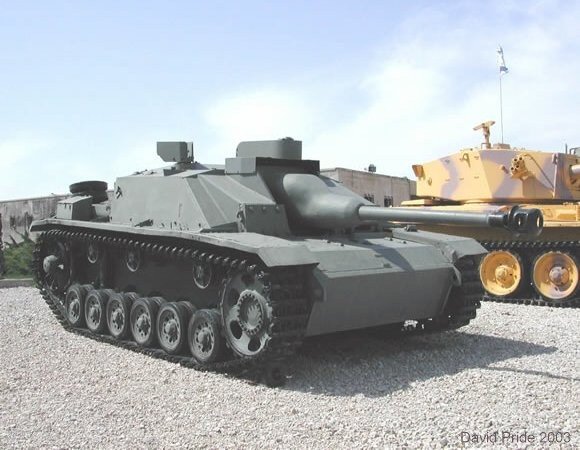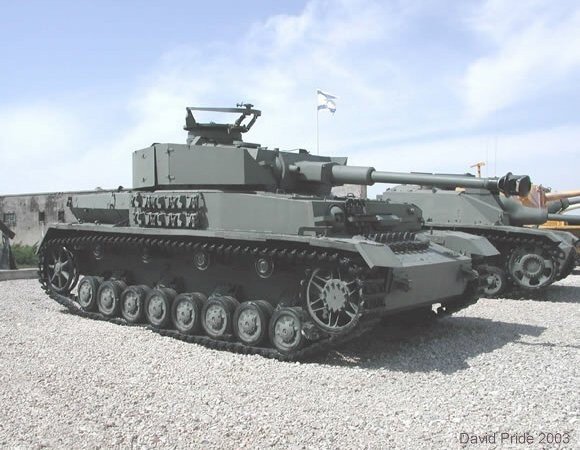privatehudson
The Ultimate Badass
- Joined
- Oct 15, 2003
- Messages
- 4,821
Beg, Borrow, Steal: A story of how Israel first armed itself
Part One: The Armoured Corps
The history of the Israeli army is not a long one, but is certainly one filled with skill and finessee that has often defied the odds. The Israeli Defence Force (IDF) and Israeli Air Force (IAF) have a reputation of man for man being second to none, their equipment is amongst the finest in the world, battle tested and moddified by the Israelis and honed to perfection. This though was not always the case, as this article will attempt to show. This article, the first of a pair deals with the armoured forces
The Pre-Independance Years
The story of Israel's armoured forces begins even before WWII when during 1936, the British and Haganah underground worked together to resupply the isolated settlements in the face of increasing tension and rioting from the Arab population surrounding them. The British permitted the Jews to add armour to the trucks they drove, something that slowed mobility but increased protection a little. The first "armoured" vehicles of the Jewish forces were born then. For a picture of one of the armoured trucks (though dating from the 1948 war it gives a clear idea of the style) look below
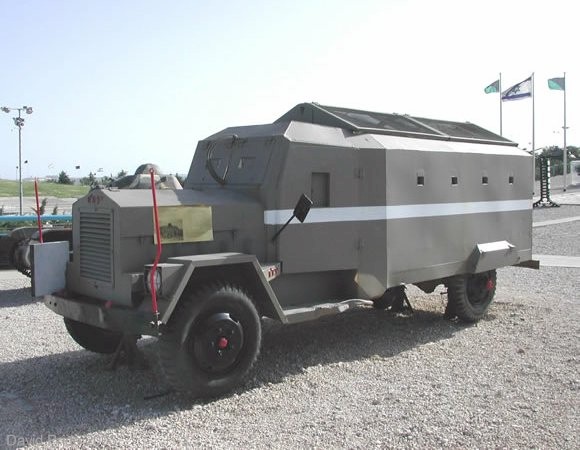
During the war years, 30,000 Palestine Jews served in two capacities, some 5000 saw combat service in the Jewish Brigade, whilst others served in the RAOC (Royal Army Ordanance Corps) and the REME (Royal Electrical and Mechanical Engineers) and similar rear areas formations. At this time, British policy did not allow them to serve as crew to tanks or armoured cars. It was here though that they gained valuble experience in repairing, and servicing shermans and other vehicles. British withdrawl policies during this period did little to help the Jewish settlements in Palestine and the increasing problems faced trying to get convoys through to the settlements forced the Haganah into the decision that they simply had to acquire some proper armour, the
race was on. Unable to legally acquire armour, they were forced to some quite unusual methods to say the least.
The British, for their own protection had dug themselves into armed and protected camps in order to protect their equipment and soldiers from both Arab and Jewish attacks. These camps though represented massive storage areas of all sorts of weapons and vehicles just waiting to be taken. The Haganah had considerable support from some British officers, and in this way managed to acquire their first two armoured cars. The first, a GMC, they persuaded a British major to "borrow" full of ammunition and drive to a rendez-vous point to be taken over by the Haganah. The second, acquired the very next day was driven out of Allenby barracks and hidden inside the
city away from the searches the British launched for it. The search was hopeless, the Haganah had acted without telling the authorities, who had no idea where the vehicles were. Within a few days, the two vehicles suceeded in driving back an attack on the Kastel redoubt (on the Jeruselam road) by a large Arab force.
The next acquisition though was sheer genius on Haganah's behalf. Discovering that the British were dumping hundreds of AFVs over a cliff (by the Mount Carmel Road near Haifa) into a deep Wadi due to being unable to evacuate them all in time, the Haganah took urgent steps to acquire a tank. The Haganah group in the area contacted some of the more friendly British soldiers involved in the operation (1st Airborne Squadron, RE) and struck a deal with them. Part way up the road, the Haganah waited with a makeshift transporter, awaiting the vehicle. It finally came and was transported onto the Haganah vehicle, with the RE vehicle continuing on like nothing had gone wrong. The transporter continued towards Tel Aviv, but burst tires nearly caught it out before they could be replaced.
The proud Haganah technicians unvieled their acquisition... only to discover it was missing both it's main gun and all machine guns. It lacked optical sights for the main gun, it's engine was a almost a write off, and at least two bogey wheels and many track plates were missing! This did not deter the technicians though, they'd seen worse in Egypt during the war coming from Alemien and other places. Experts were sent to evacuated REME dumps were fighting was in full swing, but even so they somehow managed to acquire enough parts to repair the engine, replace the set of optical sights and the missing wheels. The track plates were a problem though, until someone remembered that the British had used track plates laid down on the beaches of Haifa bay as a way of landing tanks easier. A quick trip proved that they had been left behind, intact and merely needed digging up. The Haganah had acquired it's very first tank... with no gun!
Another story from this period sums up the early Jewish attitudes to obtaining armour. Willing British soldiers who sympathized with the cause offered to help "liberate" four Cromwell tanks from an ordinance depot near Haifa airport. The problem was that only two trained drivers could be found, leading to hasty training of 2 Jewish drivers before the mission. The two British soldiers entered the depot, waving to the guard on the gate, and at the same time a Jewish piloted aircraft landed at the airfield. At midnight, one of the soliders offered to relieve the guard, which was accepted, and the Jewish drivers left the plane and headed for the tanks. The two British drivers started their engines and smashed their way out of the gate, however, the two Jewish drivers could not get their engines to start. Both British soldiers (sergeants) were charged with desertion, but both served with the IDF throughout the 1948 war. A picture of one of the cromwells is below:
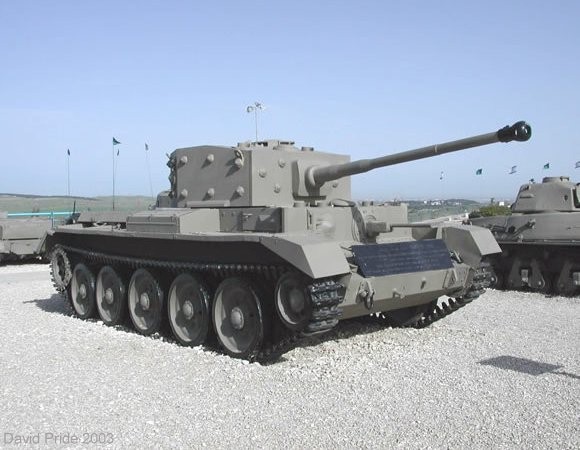
Whilst all this went on, the battle for the roads, using armoured trucks, jeeps and so on was still raging. Recognising the inherent problem with these they managed to acquire a number of dedicated armoured cars from Europe, White or Dodge variants, and armed them with MG34s. This period saw the first organised attempt to gather the vehicles together, the first armoured service and at the time numbered around 100 cars of various types. The service was soon incorporated into the new 8th Armoured brigade though the title meant little for the numbers it contained. Commanded by Yizhak Sadeh, a legendary soldier who had served with Orde Wingate in the Special Night Squads and lead the Palmach since the beginning.
By May 1948 the 8th Armoured Brigade and the remainder of the service could muster
6 ex Palestinian police GM Otters (Haganah fighters grafted machine guns onto them)
1 ex RAF Daimler MkI (armed with a 2pndr)
2 Renault R38 light tanks (captured from Syria, both had a different gun)
2 Cromwell tanks (1 armed with a 6pndr, the other with a 75mm)
1 Sherman (still without it's gun!)
Several dozen assorted home built armoured cars with light machine guns in revolving turrets, usually based on the White armoured car. Many of these were produced during the 1948 war.
A picture of one of the Syrian R38s is below:
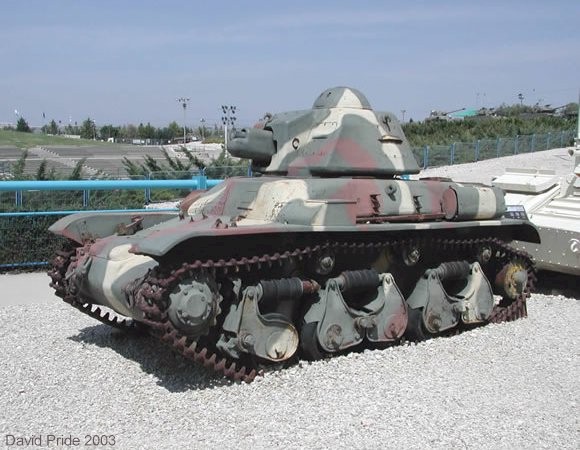
The 1948 war of Independence
This rag-tag collection was the very beginning of what would eventually be one of the finest armoured forces in the world. This then was the force with which Israel sought to defend itself against the invasion of the Arab armies in may of 1948. Even with war raging all around though, Israel continued to attempt to reinforce their units. Soon after this period the Israelis scored their first big hit, securing a large number of French Hotchkiss H39 light tanks with 37mm guns. Not perfect, but much better for having sufficient ammunition! A picture of one of these tanks is below:
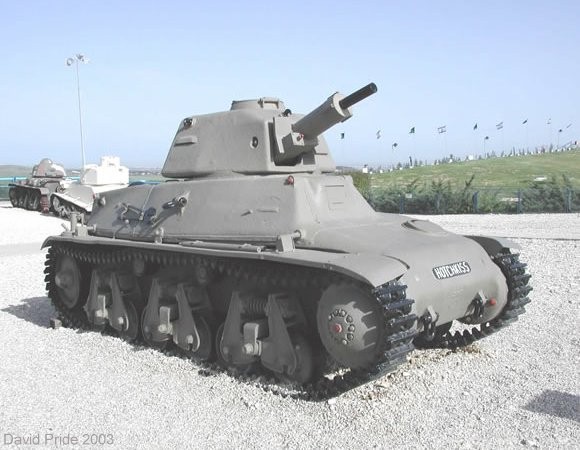
The problem lay in bringing these forces into Israel, no mean feat to say the least. With Haifa run by the British in part and Tel Aviv having an inadequate dock, UN supervision of the Mediterranean and all sorts of other problems, getting the tanks was only half the problem! The ship onto which the tanks were loaded lacked a suitable crane, but was repainted to match another similar one to confuse the UN. The Jews also moved from Haifa a floating crane towards Tel Aviv... only for it to break down! Despairing of ever reaching land the Jewish authorities finally bribed another ship with heavy cranes to unload the "agricultural machinery" onto the docks. When he found out though he nearly refused, finally agreeing after being bribed even more, the tanks were finally ashore!
This though was but part of the tale in Israel's fight for survival in 1948. I won't go into detail on the war, but comment a little on the performance and makeup of the ragtag unit that was 8th armoured. By the war's start it's armour composed:
82nd Tank Battalion (commanded by a former Red Army tank commander), comprising:
"Russian" company - One company of Hotchkiss tanks
"British" company - One company manning 2 Cromwells and 1 Sherman
The Russian company was manned by ex-red army tank crews, the British by ex-British and ex-South African tank crews due to the WWII restrictions on Palestinian Jews serving in armoured units. Communication was a nightmare, the "Russian" company spoke only spoke Russian and Yiddish, the "British" company only English. The formation survived simply because Sadeh spoke all three and eventually set up a series of interpreters. The 8th's other battalion was the 89th Commando, lead by none other than Moshe Dayan. Performances were normally high, though due to it's nature mistakes were frequent. In it's first battle during the fighting for Lydda Airport the "Russian" company got lost taking a wrong turning, but the "British" company did the job well enough anyway. Throughout the rest of the war the formation excelled itself and outperformed it's enemies almost every single time.
The post independence period
After the war the IDF was extensively reorganised, with the 8th armoured disbanded and it's armoured battalion sent to the 7th armoured brigade (a unit that fought in the 48 war as an mechanized infantry formation). The 7th re-organised it's forces, reequipped it's tanks and trained extensively. Soon after the Israeli armoured forces began to look like a museum collection of variety, the 82nd then consisting of:
"A" company
Shermans using 75mm Krupp M1911 guns mounted on 105mm loading mechanisms! These vehicles had been bought from surplus US army dumps in Italy but the guns had been removed or rendered unserviceable. Not to be defeated, the Israelis scoured Europe, finding in all places Switzerland some of the above guns, which had been stored in a cave since their purchase after WWI (yes the 1911 really does mean they're that old!). With ammunition in abundance, they suited Israeli needs immensely and they were soon mounted, with the aid of screws, adaptors and welding to the tanks in a way that they could fire using direct fire HE in support of infantry attacks... just at safe distances!
"B" company
A strange amalgamation of vehicles, one Sherman M4A2, several M4A3s (for which almost no ammunition was available) and 1 Sherman Firefly... for which they had NO ammunition. With two other companies mounted in half tracks, the battalion had quite an aspect of farce to it!
A picture of one of the Shermans from this period is below:
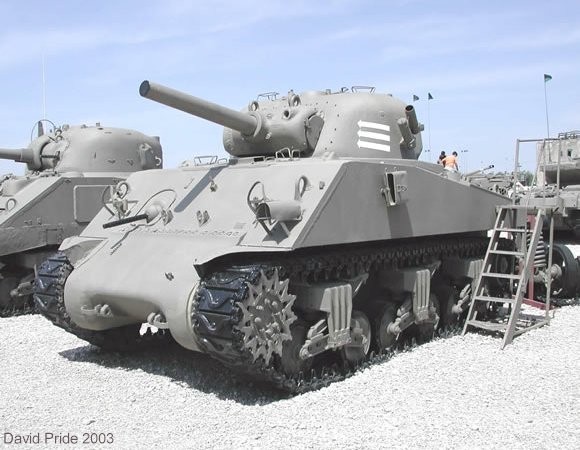
A picture of one of the M2 halftracks used is below:
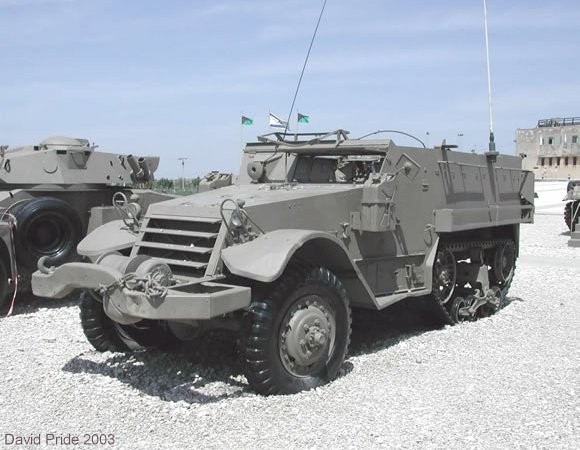
The Israelis soon settled down to training more crews and officers in the skills of armoured combat and sending officers to the French schools at Samur to learn the tricks of the trade alongside Syrian officers they had recently fought against. In the early years of the 50s the Israelis further purchased standard Shermans (this time from dumps in the Phillipines of all places!) and re-organised their armour into 4 regular companies of 17 tanks each.
And there the story ends. From here on, though most of their purchases of tanks were clandestine, they were almost always legal and proper. Israel's armour had grown into a force that within a few short years would devastate the Egyptian army in the Sinai, within 15 years or so would annihilate the armies of Syria, Egypt and Jordan and within 30 years would threaten both Damascus and Egypt beyond the Suez canal. It is an achievement that you have to admire, from literally nothing, to a farcical mix that would grace a wacky races cartoon rather than an army, to an elite fighting machine. Israel's armoured force has come a long way since the end of WWII, it seems almost impossible to think of the country that gave us the genius of the 6 days war began so humbly, yet so brilliantly. This was the story of that humble beginning, I do hope you have found it as interesting as I always have
Please note:
Anyone looking for information on the Arab forces deployed against this rag-tag bunch during the 1948 war can PM me for details
All pictures in this post only are specifically from This site and the vehicles all reside in the IDF museum
Any reference to "arab" or "jew" or similar is not intended as a slur, and if people would prefer another term, think of my use of it as for simplicity. I have tried not to make any judgement on the events or introduce any specifically unfair bias also.
Part One: The Armoured Corps
The history of the Israeli army is not a long one, but is certainly one filled with skill and finessee that has often defied the odds. The Israeli Defence Force (IDF) and Israeli Air Force (IAF) have a reputation of man for man being second to none, their equipment is amongst the finest in the world, battle tested and moddified by the Israelis and honed to perfection. This though was not always the case, as this article will attempt to show. This article, the first of a pair deals with the armoured forces

The Pre-Independance Years
The story of Israel's armoured forces begins even before WWII when during 1936, the British and Haganah underground worked together to resupply the isolated settlements in the face of increasing tension and rioting from the Arab population surrounding them. The British permitted the Jews to add armour to the trucks they drove, something that slowed mobility but increased protection a little. The first "armoured" vehicles of the Jewish forces were born then. For a picture of one of the armoured trucks (though dating from the 1948 war it gives a clear idea of the style) look below

During the war years, 30,000 Palestine Jews served in two capacities, some 5000 saw combat service in the Jewish Brigade, whilst others served in the RAOC (Royal Army Ordanance Corps) and the REME (Royal Electrical and Mechanical Engineers) and similar rear areas formations. At this time, British policy did not allow them to serve as crew to tanks or armoured cars. It was here though that they gained valuble experience in repairing, and servicing shermans and other vehicles. British withdrawl policies during this period did little to help the Jewish settlements in Palestine and the increasing problems faced trying to get convoys through to the settlements forced the Haganah into the decision that they simply had to acquire some proper armour, the
race was on. Unable to legally acquire armour, they were forced to some quite unusual methods to say the least.
The British, for their own protection had dug themselves into armed and protected camps in order to protect their equipment and soldiers from both Arab and Jewish attacks. These camps though represented massive storage areas of all sorts of weapons and vehicles just waiting to be taken. The Haganah had considerable support from some British officers, and in this way managed to acquire their first two armoured cars. The first, a GMC, they persuaded a British major to "borrow" full of ammunition and drive to a rendez-vous point to be taken over by the Haganah. The second, acquired the very next day was driven out of Allenby barracks and hidden inside the
city away from the searches the British launched for it. The search was hopeless, the Haganah had acted without telling the authorities, who had no idea where the vehicles were. Within a few days, the two vehicles suceeded in driving back an attack on the Kastel redoubt (on the Jeruselam road) by a large Arab force.
The next acquisition though was sheer genius on Haganah's behalf. Discovering that the British were dumping hundreds of AFVs over a cliff (by the Mount Carmel Road near Haifa) into a deep Wadi due to being unable to evacuate them all in time, the Haganah took urgent steps to acquire a tank. The Haganah group in the area contacted some of the more friendly British soldiers involved in the operation (1st Airborne Squadron, RE) and struck a deal with them. Part way up the road, the Haganah waited with a makeshift transporter, awaiting the vehicle. It finally came and was transported onto the Haganah vehicle, with the RE vehicle continuing on like nothing had gone wrong. The transporter continued towards Tel Aviv, but burst tires nearly caught it out before they could be replaced.
The proud Haganah technicians unvieled their acquisition... only to discover it was missing both it's main gun and all machine guns. It lacked optical sights for the main gun, it's engine was a almost a write off, and at least two bogey wheels and many track plates were missing! This did not deter the technicians though, they'd seen worse in Egypt during the war coming from Alemien and other places. Experts were sent to evacuated REME dumps were fighting was in full swing, but even so they somehow managed to acquire enough parts to repair the engine, replace the set of optical sights and the missing wheels. The track plates were a problem though, until someone remembered that the British had used track plates laid down on the beaches of Haifa bay as a way of landing tanks easier. A quick trip proved that they had been left behind, intact and merely needed digging up. The Haganah had acquired it's very first tank... with no gun!
Another story from this period sums up the early Jewish attitudes to obtaining armour. Willing British soldiers who sympathized with the cause offered to help "liberate" four Cromwell tanks from an ordinance depot near Haifa airport. The problem was that only two trained drivers could be found, leading to hasty training of 2 Jewish drivers before the mission. The two British soldiers entered the depot, waving to the guard on the gate, and at the same time a Jewish piloted aircraft landed at the airfield. At midnight, one of the soliders offered to relieve the guard, which was accepted, and the Jewish drivers left the plane and headed for the tanks. The two British drivers started their engines and smashed their way out of the gate, however, the two Jewish drivers could not get their engines to start. Both British soldiers (sergeants) were charged with desertion, but both served with the IDF throughout the 1948 war. A picture of one of the cromwells is below:

Whilst all this went on, the battle for the roads, using armoured trucks, jeeps and so on was still raging. Recognising the inherent problem with these they managed to acquire a number of dedicated armoured cars from Europe, White or Dodge variants, and armed them with MG34s. This period saw the first organised attempt to gather the vehicles together, the first armoured service and at the time numbered around 100 cars of various types. The service was soon incorporated into the new 8th Armoured brigade though the title meant little for the numbers it contained. Commanded by Yizhak Sadeh, a legendary soldier who had served with Orde Wingate in the Special Night Squads and lead the Palmach since the beginning.
By May 1948 the 8th Armoured Brigade and the remainder of the service could muster
6 ex Palestinian police GM Otters (Haganah fighters grafted machine guns onto them)
1 ex RAF Daimler MkI (armed with a 2pndr)
2 Renault R38 light tanks (captured from Syria, both had a different gun)
2 Cromwell tanks (1 armed with a 6pndr, the other with a 75mm)
1 Sherman (still without it's gun!)
Several dozen assorted home built armoured cars with light machine guns in revolving turrets, usually based on the White armoured car. Many of these were produced during the 1948 war.
A picture of one of the Syrian R38s is below:

The 1948 war of Independence
This rag-tag collection was the very beginning of what would eventually be one of the finest armoured forces in the world. This then was the force with which Israel sought to defend itself against the invasion of the Arab armies in may of 1948. Even with war raging all around though, Israel continued to attempt to reinforce their units. Soon after this period the Israelis scored their first big hit, securing a large number of French Hotchkiss H39 light tanks with 37mm guns. Not perfect, but much better for having sufficient ammunition! A picture of one of these tanks is below:

The problem lay in bringing these forces into Israel, no mean feat to say the least. With Haifa run by the British in part and Tel Aviv having an inadequate dock, UN supervision of the Mediterranean and all sorts of other problems, getting the tanks was only half the problem! The ship onto which the tanks were loaded lacked a suitable crane, but was repainted to match another similar one to confuse the UN. The Jews also moved from Haifa a floating crane towards Tel Aviv... only for it to break down! Despairing of ever reaching land the Jewish authorities finally bribed another ship with heavy cranes to unload the "agricultural machinery" onto the docks. When he found out though he nearly refused, finally agreeing after being bribed even more, the tanks were finally ashore!
This though was but part of the tale in Israel's fight for survival in 1948. I won't go into detail on the war, but comment a little on the performance and makeup of the ragtag unit that was 8th armoured. By the war's start it's armour composed:
82nd Tank Battalion (commanded by a former Red Army tank commander), comprising:
"Russian" company - One company of Hotchkiss tanks
"British" company - One company manning 2 Cromwells and 1 Sherman
The Russian company was manned by ex-red army tank crews, the British by ex-British and ex-South African tank crews due to the WWII restrictions on Palestinian Jews serving in armoured units. Communication was a nightmare, the "Russian" company spoke only spoke Russian and Yiddish, the "British" company only English. The formation survived simply because Sadeh spoke all three and eventually set up a series of interpreters. The 8th's other battalion was the 89th Commando, lead by none other than Moshe Dayan. Performances were normally high, though due to it's nature mistakes were frequent. In it's first battle during the fighting for Lydda Airport the "Russian" company got lost taking a wrong turning, but the "British" company did the job well enough anyway. Throughout the rest of the war the formation excelled itself and outperformed it's enemies almost every single time.
The post independence period
After the war the IDF was extensively reorganised, with the 8th armoured disbanded and it's armoured battalion sent to the 7th armoured brigade (a unit that fought in the 48 war as an mechanized infantry formation). The 7th re-organised it's forces, reequipped it's tanks and trained extensively. Soon after the Israeli armoured forces began to look like a museum collection of variety, the 82nd then consisting of:
"A" company
Shermans using 75mm Krupp M1911 guns mounted on 105mm loading mechanisms! These vehicles had been bought from surplus US army dumps in Italy but the guns had been removed or rendered unserviceable. Not to be defeated, the Israelis scoured Europe, finding in all places Switzerland some of the above guns, which had been stored in a cave since their purchase after WWI (yes the 1911 really does mean they're that old!). With ammunition in abundance, they suited Israeli needs immensely and they were soon mounted, with the aid of screws, adaptors and welding to the tanks in a way that they could fire using direct fire HE in support of infantry attacks... just at safe distances!
"B" company
A strange amalgamation of vehicles, one Sherman M4A2, several M4A3s (for which almost no ammunition was available) and 1 Sherman Firefly... for which they had NO ammunition. With two other companies mounted in half tracks, the battalion had quite an aspect of farce to it!
A picture of one of the Shermans from this period is below:

A picture of one of the M2 halftracks used is below:

The Israelis soon settled down to training more crews and officers in the skills of armoured combat and sending officers to the French schools at Samur to learn the tricks of the trade alongside Syrian officers they had recently fought against. In the early years of the 50s the Israelis further purchased standard Shermans (this time from dumps in the Phillipines of all places!) and re-organised their armour into 4 regular companies of 17 tanks each.
And there the story ends. From here on, though most of their purchases of tanks were clandestine, they were almost always legal and proper. Israel's armour had grown into a force that within a few short years would devastate the Egyptian army in the Sinai, within 15 years or so would annihilate the armies of Syria, Egypt and Jordan and within 30 years would threaten both Damascus and Egypt beyond the Suez canal. It is an achievement that you have to admire, from literally nothing, to a farcical mix that would grace a wacky races cartoon rather than an army, to an elite fighting machine. Israel's armoured force has come a long way since the end of WWII, it seems almost impossible to think of the country that gave us the genius of the 6 days war began so humbly, yet so brilliantly. This was the story of that humble beginning, I do hope you have found it as interesting as I always have

Please note:
Anyone looking for information on the Arab forces deployed against this rag-tag bunch during the 1948 war can PM me for details

All pictures in this post only are specifically from This site and the vehicles all reside in the IDF museum
Any reference to "arab" or "jew" or similar is not intended as a slur, and if people would prefer another term, think of my use of it as for simplicity. I have tried not to make any judgement on the events or introduce any specifically unfair bias also.

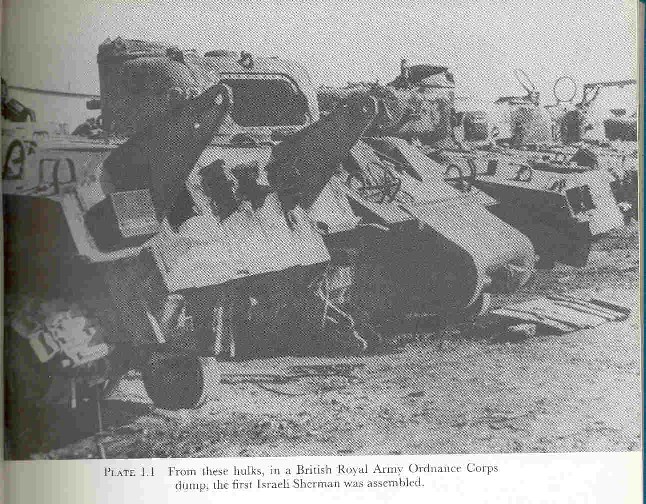
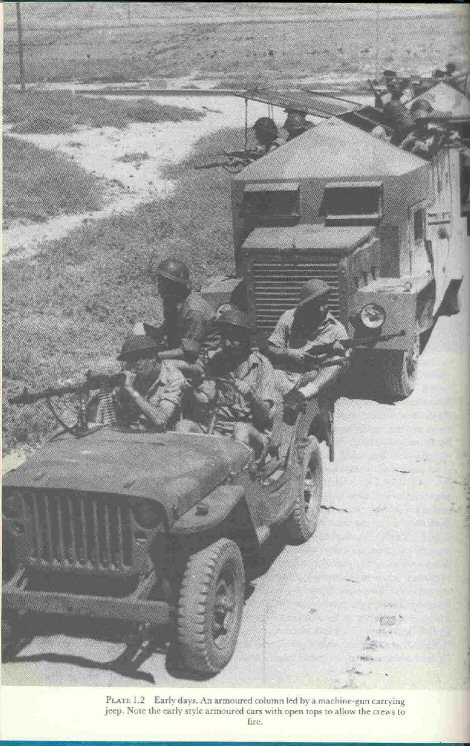
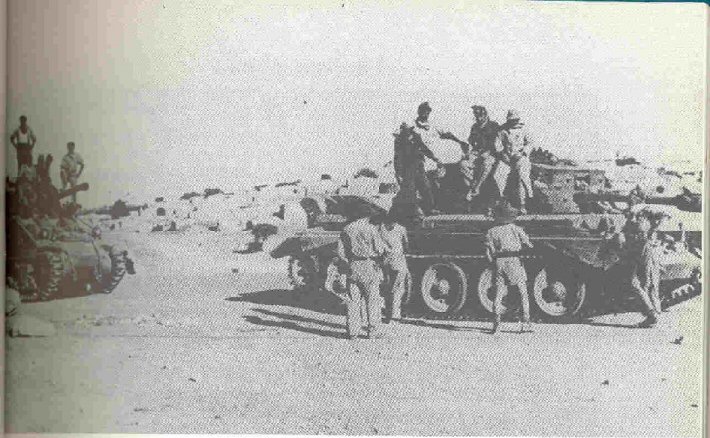
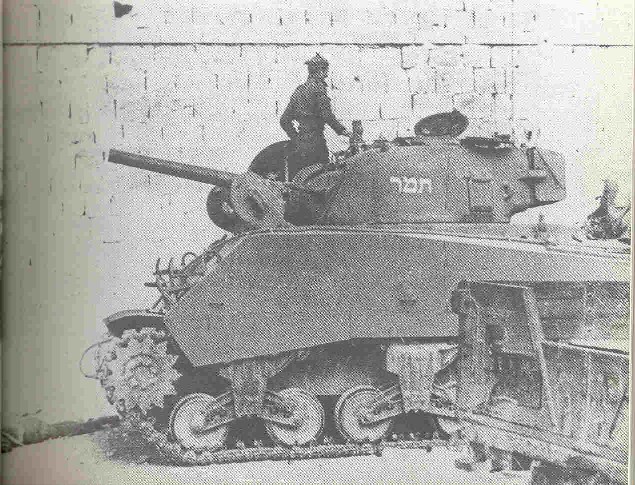
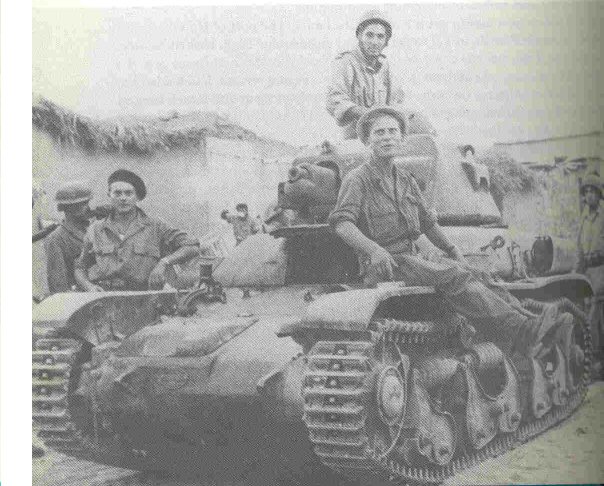
 I keep on learning in this forum...
I keep on learning in this forum... 
 I know what you mean
I know what you mean  . Looking forward
. Looking forward

